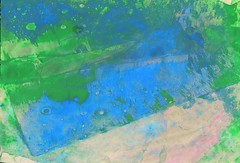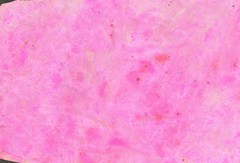
R001-015
Originally uploaded by rob helpychalk.
Aleatoric Techniques in the Work of the North Country Academy for the Excruciatingly Fine Arts
When I first began archiving the art produced at our local academy, I was quite concerned about shoddy storage techniques. Art was being produced more or less continuously, and I couldn’t even wait for a piece to dry before putting it away. A typically morning would have all of the young artists around the dining room table making an ungodly mess, and then at ten the whole thing would have to be swept away for snack time. Work got piled together wet, and later when you tried to separate them, little pieces of one artwork wound up stuck to the next artwork.
I have learned not to worry about such things, though, from the advanced aesthetic sensibilities of the students at the North Country Academy for the Excruciatingly Fine Arts (NCAEFA). Moreover, learning this lesson has made me rethink the boundaries of a work of art and the nature of the creative process.
Over the summer, we liked to hold class outside on the back porch. The artists could get paint all over themselves, and afterwards we could just hose them off in the blow up swimming pool. But the arrival of a summer cloudburst often forced us to decamp to the playroom fairly quickly, and sometimes art, which had been placed on the porch rail to dry, was left behind. One day, when I and another caregiver were trying to usher our charges indoors before the rain, I stopped to bring in a picture of Caroline’s that had been left out to dry.
“Daddy no; leave it,” said the artist.
“But it will get rained on,” I protested.
“I want it to get rained on,” came the reply.
That’s when I saw the depth of the creative mind I was working with. Random elements, which I had been thinking of as storage problems, were actually a part of the art work. Some pieces simply weren’t finished until they had been left out in the rain. Once realized this, I could see that several of the pieces were extraordinary. The image above is a scan of the work Caroline asked me to leave outside. It was not only rained on, it was caught under the downspout, folded along two axes, and soaked. The result is quite beautiful.
This next piece, as well, is a product of the rain method
Look at how the water brings out the texture of the paper.

No comments:
Post a Comment